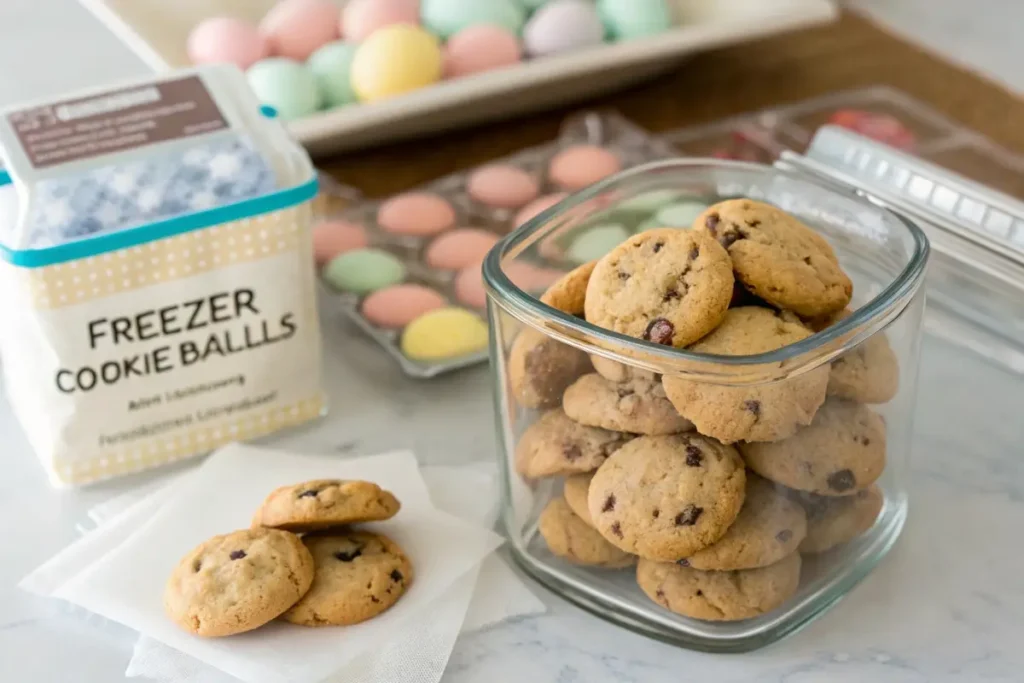Few treats scream Easter baking quite like mini egg cookies. These delightful, chocolatey cookies are packed with crunchy, colorful mini eggs, making them a must-have for spring celebrations. Whether you’re a seasoned baker or just starting out, this guide will walk you through everything—from the history of mini egg cookies to the best storage tips.
You’ll get an easy-to-follow classic mini egg cookie recipe, fun variations, and expert baking tricks to achieve the perfect chewy or crispy texture. By the end of this article, you’ll be whipping up batches of these festive chocolate egg cookies like a pro!
Introduction to Mini Egg Cookies
What Are Mini Egg Cookies?
At their core, mini egg cookies are soft, chewy cookies bursting with mini chocolate eggs—those colorful candy-coated chocolates that pop up every spring. Think of them as a fun twist on classic chocolate chip cookies, but with the festive appeal of Easter desserts. The crispy shell of the mini eggs adds an irresistible crunch, while the creamy chocolate inside melts perfectly into the dough.
These cookies aren’t just for Easter baking recipes—they’re a fantastic way to use up leftover Easter candy or simply indulge in a festive treat year-round.
The Popularity of Mini Egg Cookies During Easter
Why do mini egg cookies skyrocket in popularity every Easter? It’s simple—Cadbury and other brands release their chocolate mini eggs in limited quantities, sparking a frenzy among bakers and dessert lovers alike. These cookies symbolize springtime joy, making them a staple at Easter parties, bake sales, and family gatherings.
Beyond nostalgia, their appeal lies in their irresistible texture and flavor. The contrast between the crunchy shell, creamy chocolate, and buttery cookie dough makes them a crowd favorite. Plus, they’re ridiculously easy to bake—so whether you’re making them for kids, guests, or just yourself, these spring desserts never disappoint!
History and Origin of Mini Egg Cookies
The Inception of Mini Eggs
Before we dive into the story of mini egg cookies, let’s talk about their key ingredient—mini eggs. These pastel-colored, chocolate-filled delights were first introduced by Cadbury in 1967. Their crisp, sugary shell and creamy milk chocolate center quickly made them a seasonal favorite, especially around Easter. Over time, other brands, like Hershey’s and Mars, introduced their own versions, giving chocolate lovers even more options to enjoy.
While originally sold as a standalone Easter candy, bakers soon realized these chocolate mini eggs could be used in desserts, leading to the birth of mini egg cookies.
Evolution of Mini Egg Cookies in Baking
The idea of chocolate-filled cookies isn’t new—bakers have been adding chocolate chips to cookie dough for decades. But using mini eggs took things to a new level. The crunchy shell adds a unique texture, while the creamy chocolate inside creates a decadent bite.
As Easter baking traditions grew, mini egg cookies became a go-to treat for celebrating the season. Food bloggers, bakers, and even major food brands started sharing their own Easter cookie recipes, inspiring more home bakers to try them. Today, you’ll find countless variations, from soft-baked chewy mini egg cookies to crispy, golden-brown ones packed with extra chocolate.
With their nostalgic charm and unbeatable taste, it’s no wonder mini egg cookies have become a must-have in every baker’s recipe collection!
Essential Ingredients for Perfect Mini Egg Cookies
Key Components: Flour, Sugars, and Fats
Like any great cookie recipe, mini egg cookies rely on the perfect balance of flour, sugars, and fats. Each ingredient plays a crucial role:
- Flour: Provides structure. Most recipes use all-purpose flour, but you can swap in gluten-free flour for an allergy-friendly version.
- Sugars: A mix of brown sugar and white sugar creates the ideal texture. Brown sugar adds moisture for a chewier bite, while white sugar helps with crispness.
- Butter or Oil: Butter gives cookies a rich, melt-in-your-mouth flavor, while oil can be used for a softer texture.
Choosing the Right Mini Eggs for Your Cookies
Not all mini eggs are the same! While Cadbury mini eggs are the classic choice, other brands like Hershey’s and store-brand versions also work. The key is finding mini eggs with a crisp outer shell and creamy chocolate inside. If you prefer a stronger chocolate flavor, try using dark chocolate mini eggs instead of milk chocolate.
Pro Tip: Gently crush some mini eggs before mixing them into your cookie dough. This spreads the chocolate throughout the cookies while still keeping some whole for that extra crunch!
Optional Add-ins: Nuts, Dried Fruits, and Flavorings
Want to take your mini egg cookies to the next level? Try these fun add-ins:
- Chopped nuts like walnuts or pecans for a crunchy texture.
- Dried cranberries or coconut flakes for a fruity, tropical twist.
- A hint of cinnamon or sea salt to enhance the chocolate flavor.
Experiment with different flavors and textures to make your own unique version of mini egg cookies!
Step-by-Step Recipe for Classic Mini Egg Cookies

Gathering and Measuring Ingredients
Before diving into baking, it’s essential to have all your ingredients ready and accurately measured. For these delightful mini egg cookies, you’ll need:
- 1 cup unsalted butter, softened
- 1 cup brown sugar, packed
- 1/2 cup granulated sugar
- 2 large eggs, at room temperature
- 2 teaspoons pure vanilla extract
- 3 cups all-purpose flour
- 1 teaspoon baking soda
- 1/2 teaspoon baking powder
- 1/2 teaspoon salt
- 1 cup chopped mini chocolate eggs
- 1 cup semi-sweet chocolate chips
Having your ingredients at room temperature, especially the butter and eggs, ensures a smoother mixing process and a better-textured cookie.
Mixing Techniques for Optimal Dough Consistency
- Creaming the Butter and Sugars: In a large mixing bowl, beat the softened butter, brown sugar, and granulated sugar together until the mixture is light and fluffy. This process incorporates air, leading to a tender cookie.
- Adding Eggs and Vanilla: Add the eggs one at a time, beating well after each addition. Stir in the vanilla extract. This step ensures the wet ingredients are well combined, providing a uniform base for your dough.
- Incorporating Dry Ingredients: In a separate bowl, whisk together the all-purpose flour, baking soda, baking powder, and salt. Gradually add this dry mixture to the wet ingredients, mixing on low speed until just combined. Overmixing can lead to tough cookies, so mix until you no longer see streaks of flour.
- Folding in the Chocolate: Gently fold in the chopped mini eggs and semi-sweet chocolate chips using a spatula, ensuring even distribution throughout the dough.
Baking Tips for Soft and Chewy Cookies
- Chilling the Dough: For best results, cover the bowl with plastic wrap and refrigerate the dough for at least 30 minutes. Chilling helps prevent the cookies from spreading too much during baking and enhances the flavor.
- Preheating the Oven: Preheat your oven to 350°F (175°C). Line baking sheets with parchment paper to prevent sticking and ensure even baking.
- Scooping the Dough: Use a cookie scoop or tablespoon to drop rounded balls of dough onto the prepared baking sheets, spacing them about 2 inches apart to allow for spreading.
- Baking Time: Bake the cookies for 10-12 minutes, or until the edges are lightly golden, and the centers appear slightly underbaked. This technique yields a soft, chewy center once cooled.
- Cooling: Allow the cookies to cool on the baking sheet for 5 minutes before transferring them to a wire rack to cool completely. This step helps the cookies set and prevents them from breaking apart.
For more delicious recipes, check out our recipe article.
Variations and Twists on Mini Egg Cookies

Incorporating Different Types of Chocolate
While traditional mini egg cookies feature milk chocolate eggs, experimenting with various chocolates can elevate your cookies:
- Dark Chocolate Mini Eggs: For a richer, less sweet flavor, substitute milk chocolate mini eggs with dark chocolate ones. The slight bitterness of dark chocolate pairs well with the cookie’s sweetness.
- White Chocolate Chips: Adding white chocolate chips alongside mini eggs introduces a creamy sweetness, creating a delightful contrast in both flavor and appearance.
Adding Oats for Texture
To introduce a hearty texture and a hint of nuttiness:
- Oatmeal Mini Egg Cookies: Replace one cup of all-purpose flour with one cup of old-fashioned rolled oats. The oats add chewiness and depth, making the cookies more filling and flavorful.
- Coconut Flakes: Incorporate half a cup of unsweetened shredded coconut into the dough. The coconut complements the chocolate and adds a tropical twist to the classic cookie.
Creating Gluten-Free and Vegan Versions
Accommodating dietary preferences doesn’t mean compromising on taste:
- Gluten-Free Mini Egg Cookies: Substitute all-purpose flour with a gluten-free all-purpose baking mix. Ensure that all other ingredients, including mini eggs, are certified gluten-free.
- Vegan Mini Egg Cookies: Replace butter with plant-based margarine or coconut oil, and use flax eggs (1 tablespoon ground flaxseed mixed with 3 tablespoons water per egg) instead of chicken eggs. While traditional mini eggs contain dairy, seek out vegan-friendly chocolate candies or use dairy-free chocolate chips as a substitute.
By exploring these variations, you can customize mini egg cookies to suit different tastes and dietary needs, ensuring everyone can enjoy this delightful treat.
Tips for Storing and Preserving Freshness
Proper Storage Containers and Methods
To keep mini egg cookies fresh and delicious for days, proper storage is key. Once the cookies have completely cooled, store them in an airtight container at room temperature. This prevents moisture loss, keeping the cookies soft and chewy. If stacking cookies in the container, place a sheet of parchment paper between layers to avoid sticking.
For longer freshness, store mini egg cookies in a cool, dry place away from direct sunlight or heat sources. If you prefer crispier cookies, leave the lid slightly open to allow airflow.

Freezing Dough vs. Baked Cookies
Want to enjoy mini egg cookies later? Freezing is a great option!
- Freezing Cookie Dough: Scoop the cookie dough onto a baking sheet, forming dough balls. Freeze them until solid, then transfer them into a zip-top freezer bag. Label with the date, and store for up to 3 months. When ready to bake, place frozen dough balls on a lined baking sheet and bake for an extra 2-3 minutes longer than usual.
- Freezing Baked Cookies: If you’ve already baked a batch, let the cookies cool completely before storing them in an airtight container or freezer bag. Freeze for up to 3 months and thaw at room temperature for 15-20 minutes before serving.
By following these storage tips, you can keep your mini egg cookies tasting freshly baked for weeks!
Frequently Asked Questions About Mini Egg Cookies
No, Mini Eggs are not being discontinued. While some limited-edition varieties, like the dark chocolate Mini Eggs, were discontinued in 2019, the classic milk chocolate Mini Eggs remain a seasonal favorite, especially during Easter. You can still find them in most stores and online during the spring season.
The outer shell of Mini Eggs is made of a crisp sugar coating that gives them their signature pastel colors and crunchy texture. This coating protects the creamy milk chocolate center inside, making Mini Eggs a delicious combination of crunch and smoothness.
Yes, you can use older eggs for baking, but they must still be fresh and safe to eat. A simple way to check egg freshness is the float test: Place the egg in a bowl of water—if it sinks, it’s fresh; if it floats, it’s too old to use. Using slightly older eggs in cookies won’t affect the taste or texture much, but always ensure they are not expired.
The shell of Mini Eggs is made of a sugar-based coating, along with food colorings to achieve their festive pastel appearance. This crunchy outer layer contrasts perfectly with the creamy milk chocolate filling, making Mini Eggs a favorite treat for baking and snacking.
Conclusion and Encouragement to Experiment
Recap of Key Points
By now, you have everything you need to bake the perfect batch of mini egg cookies! From understanding their origins to learning the best baking techniques, you’re ready to make these delightful treats whenever the craving strikes. Remember to:
- Use a mix of brown and white sugar for the best texture.
- Chill the dough before baking to control spreading.
- Experiment with chocolate variations, oats, or coconut for unique flavors.
- Store or freeze them properly to keep them fresh longer.
Inspiring Readers to Create Their Own Mini Egg Cookie Variations
Baking is all about creativity! Don’t be afraid to put your own spin on mini egg cookies—whether it’s using dark chocolate, adding nuts, or making them gluten-free. Share them with family and friends, or bake a fresh batch for Easter celebrations.
Now, grab your ingredients and start baking! Who knows? You might just create the best mini egg cookie recipe yet.


6 thoughts on “7 Must-Know Facts About Mini Eggs – Everything You Need to Know!”